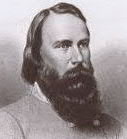Gil R.
Posts: 10821
Joined: 4/1/2005
Status: offline

|
Here's Meredith's bio. I made some changes using jkBluesman's suggestions, and rewrote a bit, but it's mostly unchanged. Let me know if the ratings or abilities seem off.
Brig. Gen. Solomon Meredith (b. 1810, d. 1875). Meredith was born in Guilford, North Carolina and at the age of nineteen moved to Indiana, where he worked as a farm laborer to pay for his education. At the age of twenty-four, he was elected sheriff and served two terms. Meredith served four terms in the state legislature and was appointed U.S. Marshal in 1849. When troops were being raised after the outbreak of the Civil War, Gov. Oliver P. Morton appointed Meredith Colonel of the 19th Indiana Infantry Regiment. Upon arriving in Washington, D.C. in August, Meredith boldly visited Pres. Abraham Lincoln to ask for new blue uniforms for his regiment, but it was for its hats that this regiment became more known, since the 19th Indiana was to become part of the famed “Iron Brigade,” which also was known as the “Black Hat Brigade” (or “Black-Hat Boys”) because of the black Hardee hats the men wore. Meredith’s most notable moment with the 19th Indiana came at the Second Battle of Bull Run, the their first experience with combat, when the regiment suffered 259 casualties in fighting against Gen. “Stonewall” Jackson, and Meredith himself was severely wounded after his horse was shot out from underneath him. Meredith survived being crushed by the horse, suffering some broken ribs, and in October 1862 was promoted to brigadier general, but not without some raised eyebrows: he had long lobbied for the position, having first written Morton on April 17, 1861 to ask for an appointment at this rank, and later had been recommended for promotion by Gen. Joseph Hooker in recognition of his achievements in the Battle of Antietam – a battle at which Meredith was not present. The following month, Meredith received command of the Iron Brigade, which by then was comprised of two Indiana, one Michigan, and three Wisconsin regiments. Meredith’s predecessor, Gen. John Gibbon, was opposed to Meredith’s promotion, but the brigade’s other colonels liked Meredith and gladly served under him. At the Battle of Fredericksburg on December 13, Meredith’s first battle in brigade command, the Iron Brigade was not heavily engaged, losing just sixty-five men, but Meredith failed to execute an order given by his division commander, Gen. Abner Doubleday, toward the end of the day. While there is a possibility that Meredith never received the order, Doubleday was so incensed when the order had not been carried out after two hours that he relieved Meredith on the spot. With his political connections, however, Meredith regained command in time to lead the brigade at Chancellorsville the following spring. In this major battle the Iron Brigade was only lightly engaged, but at Gettysburg on July 1 it lost two-thirds of its force in the early fighting, and Meredith received a disabling wound when a piece of shrapnel hit him in the head and knocked him unconscious, following which his dead horse fell on top of him. Neither the Iron Brigade nor Meredith ever fully recovered, though both continued to serve in the war: the Iron Brigade was reformed and its surviving, battle-ready troops still fought, while in early 1864 Meredith, having recovered from his wound, was given garrison duty in Cairo, Illinois. That September, Meredith was transferred to Paducah, Kentucky, where he remained until the war ended. Following the war, Meredith served as Surveyor General of the Montana Territory from 1867 to 1869. In 1869, he retired to his farm near Cambridge City, Indiana, where he raised prized longhorn cattle. Meredith is buried in Riverside Cemetery in Cambridge City. (Bio by Scott Jennings)
Leadership: 4
Tactics: 4
Initiative: 3
Command: 4
Cavalry:
Start date: 42 or 43
Teaches: Steady (14), Brave (2), Resilient (23)
|
 Printable Version
Printable Version







 New Messages
New Messages No New Messages
No New Messages Hot Topic w/ New Messages
Hot Topic w/ New Messages Hot Topic w/o New Messages
Hot Topic w/o New Messages Locked w/ New Messages
Locked w/ New Messages Locked w/o New Messages
Locked w/o New Messages Post New Thread
Post New Thread